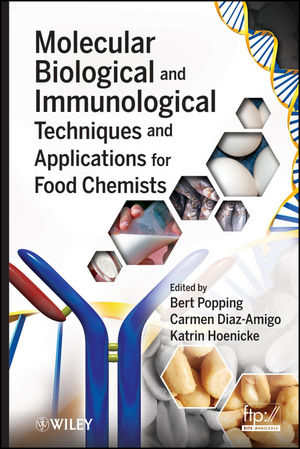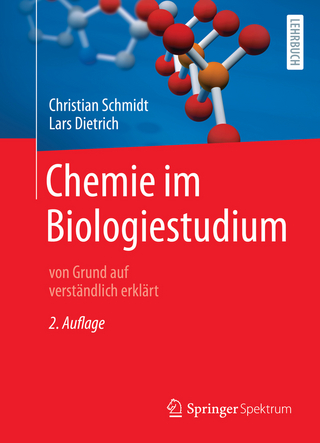
Molecular Biological and Immunological Techniques and Applications for Food Chemists
John Wiley & Sons Inc (Verlag)
978-0-470-06809-0 (ISBN)
- Titel z.Zt. nicht lieferbar
- Versandkostenfrei innerhalb Deutschlands
- Auch auf Rechnung
- Verfügbarkeit in der Filiale vor Ort prüfen
- Artikel merken
A guide to using molecular biology and immunological methods for the analysis of food Many of the analytical problems that food chemists face in the lab cannot be solved by chemistry alone, and so analytical chemists are turning to molecular biology and immunology for alternative approaches. Molecular Biological and Immunological Techniques and Applications for Food Chemists comprehensively explains the most important molecular biology and immunology methods, and illustrates their application in food analysis.
Written by a distinguished group of experts, the coverage includes:
Molecular Biological Methods—techniques explained, laboratory layout, PCR, real-time PCR, RFLP, SSCP, and sequencing
Molecular Biology Applications—meat, genetically modified organisms (GMOs), food allergens, offal, and fish
Immunological Methods—techniques explained and antibody-based detection methods
Immunology Applications—animal speciation, international food allergen regulations (except Japanese), Japanese regulations and buckwheat allergen detection, egg allergen detection, soy allergen detection, milk allergen detection, gluten allergen detection, nut allergen detection, fish allergen detection, lupin allergen detection, mustard allergen detection, and celery allergen detection
Clearly written and consistently edited to provide information to a wide range of readers, Molecular Biological and Immunological Techniques and Applications for Food Chemists offers an up-to-date reference for food scientists in government and industry, policymakers, and graduate-level students of food science, technology, and engineering.
BERT POPPING is the Director of Molecular Biology and Immunology at Eurofins Scientific Group. Dr. Popping is a member of the AOAC International Presidential Taskforce on food allergens, the AOAC General Referee for Food Allergen Methods, leading the Allergen Working Group within the European Sixth Framework Programme MoniQA, and is a member of several national and international working groups. He is a member of the Scientific Advisory Panel for the American Association of Cereal Chemists (AACC), and is on the Board of Directors for the AOAC Research Institute. CARMEN DIAZ-AMIGO is a Research Biologist with the Center for Food Safety and Applied Nutrition at the U.S. Food and Drug Administration. She has been involved in the strategic research planning of the FDA. She is a member of several national and international working groups including the AOAC International Presidential Taskforce onfood allergens, and the Allergen Working Group within the European Sixth Framework Programme MoniQA. KATRIN HOENICKE is a Food Chemist and member of the management of the Eurofins Competence Center for Contaminants in Foods, WEJ Contaminants, in Hamburg, Germany. She is a member of several national and international working groups including the AOAC European Executive Committee.
CONTRIBUTORS. PREFACE.
PART Ia MOLECULAR BIOLOGICAL METHODS: TECHNIQUES EXPLAINED.
1. Molecular Biology Laboratory Layout (Rainer Schubbert).
2. Polymerase Chain Reaction (Hermann Broll).
3. Quantitative Real-Time PCR (Hermann Broll).
4. Polymerase Chain Reaction–Restriction Fragment Length Polymorphism Analysis (Klaus Pietsch and Hans-Ulrich Waiblinger).
5. Single-Stranded Conformation Polymorphism Analysis (Hartmut Rehbein).
6. Sequencing (Rainer Schubbert).
PART Ib MOLECULAR BIOLOGICAL METHODS: APPLICATIONS.
7. Meat (Ines Laube).
8. Genetically Modified Organisms (Bert Popping).
9. Detection of Food Allergens (Carmen Diaz-Amigo and Bert Popping).
10. Offal (Neil Harris).
11. Aquatic Food (Hartmut Rehbein).
PART IIa IMMUNOLOGICAL METHODS: TECHNIQUES EXPLAINED.
12. Antibody-Based Detection Methods: From Theory to Practice (Carmen Diaz-Amigo).
PART IIb IMMUNOLOGICAL METHODS: APPLICATIONS.
13. Animal Specification in Speciation (Bruce W. Ritter and Laura Allred).
14. International Regulatory Environment for Food Allergen Labeling (Samuel Benrejeb Godefroy and Bert Popping).
15. Japanese Regulations and Buckwheat Allergen Detection (Hiroshi Akiyama, Shinobu Sakai, Reiko Adachi, and Reiko Teshima).
16. Egg Allergen Detection (Masahiro Shoji).
17. Soy Allergen Detection (Marcello Gatti and Cristina Ferretti).
18. Milk Allergen Detection (Sabine Baumgartner).
19. Gluten Detection (Ulrike Immer and Sigrid Haas-Lauterbach).
20. Nut Allergen Detection (Richard Fielder, Warren Higgs, and Katie Barden).
21. Fish Allergen Detection (Christiane Kruse Fæste).
22. Lupin Allergen Detection (Christiane Kruse Fæste).
23. Mustard Allergen Detection (Anne E. Ryan and Michael S. Ryan).
24. Celery Allergen Detection (Charlotta Engdahl Axelsson).
INDEX.
| Erscheint lt. Verlag | 12.1.2010 |
|---|---|
| Verlagsort | New York |
| Sprache | englisch |
| Maße | 164 x 244 mm |
| Gewicht | 798 g |
| Themenwelt | Naturwissenschaften ► Biologie ► Biochemie |
| Naturwissenschaften ► Biologie ► Genetik / Molekularbiologie | |
| Technik ► Lebensmitteltechnologie | |
| Weitere Fachgebiete ► Land- / Forstwirtschaft / Fischerei | |
| ISBN-10 | 0-470-06809-4 / 0470068094 |
| ISBN-13 | 978-0-470-06809-0 / 9780470068090 |
| Zustand | Neuware |
| Haben Sie eine Frage zum Produkt? |
aus dem Bereich


